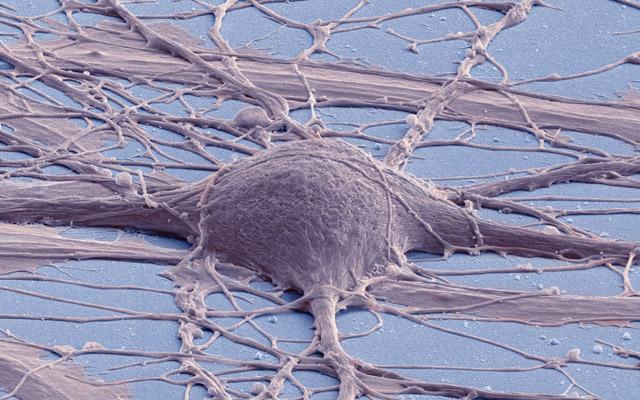Scientists at the University of California San Diego School of Medicine have created spinal cord neural stem cells (NSC) from embryonic human pluripotent stem cells (hPSCs), which could feasibly represent a source of transplantable cells for repairing spinal cord injuries. Tests showed that the human spinal cord NSCs can be maintained over long periods in culture, and when transplanted into the injured spinal cords of experimental rats, differentiated into all the major neural cell types. The grafts were particularly rich in excitatory neurons, and extended large numbers of axons over long distances, forming synapses with host’s nerve cells, innervating their target structures, and promoting corticospinal regeneration and improvements in the animals’ motor function.
The scientists, headed by Mark Tuszynski, M.D., Ph.D., professor of neuroscience and director of the UC San Diego Translational Neuroscience Institute, suggest that hPSC-derived spinal cord NSCs could also represent a valuable tool for modeling spinal disorders. “We established a scalable source of human spinal cord NSCs that includes all spinal cord neuronal progenitor cell types,” comments Hiromi Kumamaru, M.D., Ph.D., first author of the team’s published report in Nature Methods and post-doctoral scholar. “In grafts, these cells could be found throughout the spinal cord, dorsal to ventral. They promoted regeneration after spinal cord injury in adult rats, including corticospinal axons, which are extremely important in human voluntary motor function. In rats, they supported functional recovery.” Dr. Kumamaru and colleagues describe their research in a paper titled, “Generation and post-injury integration of human spinal cord neural stem cells.”
Spinal cord NSCs have the potential to be used for repairing damaged neural circuitry and to allow axonal regeneration, but to date, no one has managed to generate them in vitro, the authors note. Moreover, the utility of such cells for spinal cord repair would only be feasible if they can generate all of the key cell types required in vivo, including the different types of neurons and supporting glial cells. “For the treatment of spinal cord disorders, including spinal cord injury (SCI), amyotrophic lateral sclerosis, and spinal muscular atrophy, a source of cells with regional spinal cord identity that are capable of generating multiple neuronal and glial derivatives is needed,” they noted.
The USCD team now reports on a protocol for creating spinal cord NSCs from the H9 line of human embryonic stem cells (H9-hESCs) in vitro, based on activation of WNT and FGF2/8 signaling, and dual inhibition of SMAD2/3 signaling. Early tests showed that the resulting hESC-derived spinal cord NSCs were capable of long-term self-renewal in culture, and exhibited characteristic NSC gene expression profiles. The long-term cultured cells were also capable of spontaneously differentiating into functionally mature neurons and astrocytes, the most common type of supporting glial cells. The differentiated neurons exhibited diverse neuronal transcription factor markers specific for different neuronal subtypes, including interneurons and motor neurons.
Initial in vivo transplantation experiments in rats with spinal cord injury showed that the grafted stem cell-derived human spinal cord NSCs survived and readily extended axons into the injured host spinal cord, even months after transplantation. Within three months 80% of the graft-derived cells expressed neuronal markers, and by six months post-transplantation, the populations of graft-derived cells expressed markers for mature oligodendrocytes, astrocytes, and neurons. “These results indicate that H9-hESC-derived spinal cord NSCs can generate the three cardinal neural lineages in vivo,” the team wrote. More detailed analyses of marker expression suggested that by six months post-transplantation, the spinal cord NSC grafts had differentiated into a variety of neuronal subtypes, including motorneurons, interneurons, excitatory neurons, and inhibitory neurons. “Notably, our spinal cord NSCs predominately adopted excitatory neuronal fates,” the authors added.
The grafts extended very large numbers of human axons from the site of damage, which penetrated the spinal cord white matter and branched into host grey matter. Detailed immunoelectron microscopy suggested the formation of graft-to-host, and host-to-graft synapses, and using an approach known as mono-trans-synaptic rabies virus technology, the researchers were able to confirm that the host neurons connected with human neural grafts, which generated synaptic connections with the host’s major control centers.
Critically, the human axons formed synapses with the host spinal cord below the lesion site, “establishing a potential neural relay across the lesion site,” they wrote. The retrograde tracing technology also confirmed that the human spinal cord NSC grafts connected with all of the host animal’s brainstem and cortical neurons involved in motor function, as well as with spinal cord neuronal populations and primary sensory neurons. “These results demonstrate that graft-derived neurons receive inputs from upstream motor control centers, local and distant spinal cord interneurons, and primary sensory neurons, and thus provide evidence for synaptic connectivity with grafts of all major host systems that normally project to the spinal cord.”
Encouragingly, experiments in the rat model confirmed that the ESC-derived spinal cord NSCs supported corticospinal regeneration, which is key to the ability to reacquire voluntary movement. Transplantation experiments in rats with clinically relevant spinal cord injuries demonstrated that over the course of 2-3 months the hESC-derived spinal cord NSC grafts allowed the animals to regain some hind-limb motor function, including how they stepped, and coordination between limbs.
The researchers say their culture system offers the potential for scale up to derive cells for treating spinal cord injury in a clinical setting, although they acknowledge that further studies will be needed to test the safety and effectiveness of the approach first in nonhuman primates. The ability to yield a broad range of spinal cord neuronal types and glial cell types could also help scientists model diseases and develop screening approaches for spinal cord disorders such as amyotrophic lateral sclerosis, progressive muscular atrophy, hereditary spastic paraplegia and spinocerebellar ataxia. “hPSC-derived spinal cord NSCs could enable a broad range of biomedical applications for in vitro disease modeling and constitute an improved clinically translatable cell source for ‘replacement’ strategies in several spinal cord disorders,” they concluded.







